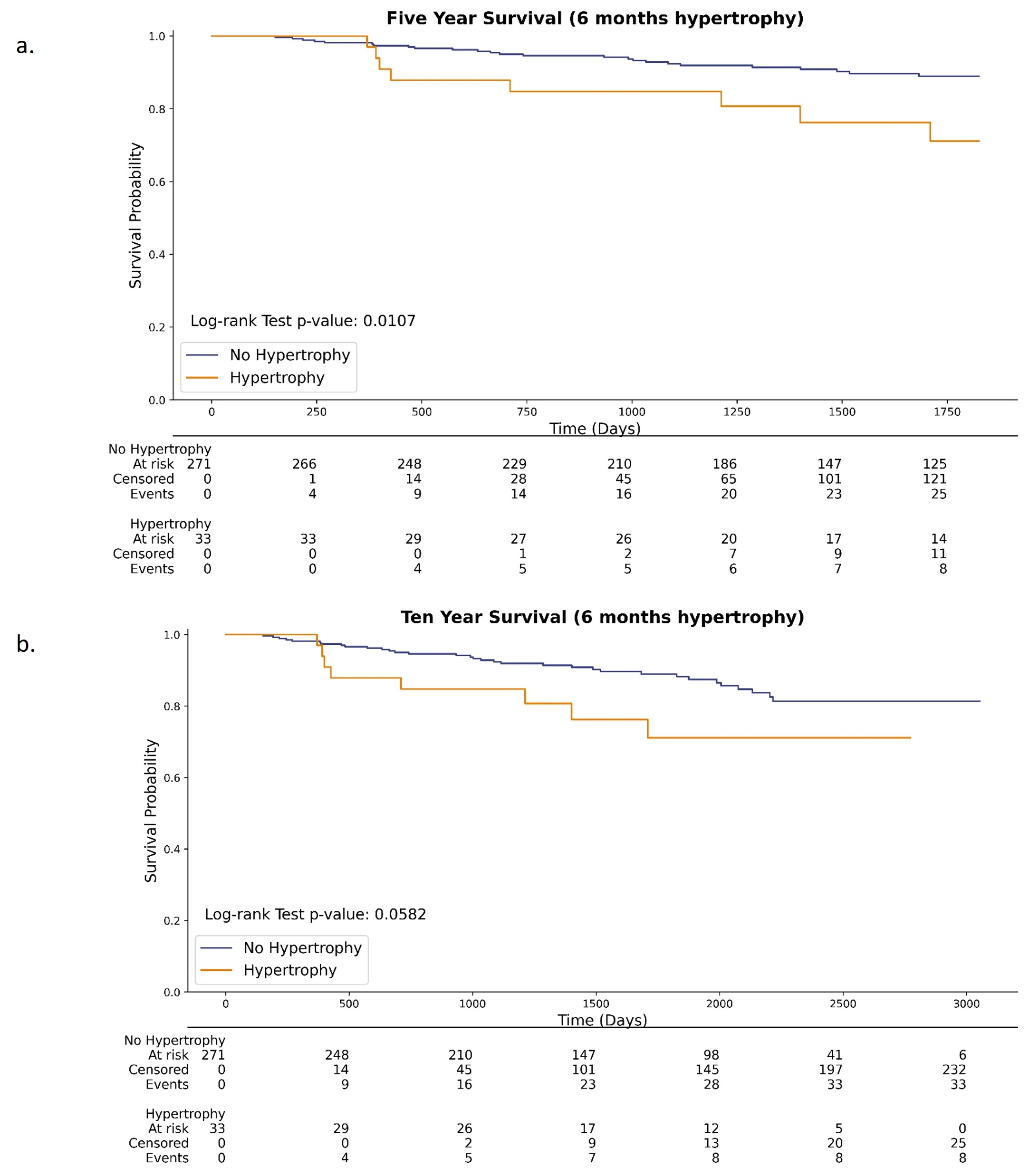Final ID: MDP104
Cardiac Allograft Hypertrophy (CAH) at 6 Months Post Transplant Is a Prognostic Marker of Long-Term Outcomes: Are We Missing a Simple Biomarker?
Abstract Body (Do not enter title and authors here): Introduction: Cardiac hypertrophy is a known adverse prognostic marker in various non-transplant pathologies. In heart transplant patients, due to many confounders, it has been controversial on the relevance and timing of cardiac hypertrophy as an adverse remodeling vs acute injury pattern in an immunologically hostile environment. Previous studies have shown prognostication of hypertrophy on echocardiogram at 1-year post-heart transplant.
Research Questions: Does cardiac hypertrophy within a year after transplant have long-term prognostic implications?
Methods: We collected relevant clinical variables for all heart transplants using EPIC EHR’s Clarity database. Hypertrophy was defined based on LV Mass Indexed to body surface area where LV Mass = 0.8 x (1.04 x (((LVIDD + IVSd + PWd)3 - LVIDD3))) + 0.6. Relative Wall Thickness was defined as RWT = 2 x PWd / LVIDD. We used a rule-based natural language processing program validated by correlation with manual readings by trained cardiologists (r=0.96, p=0.007) to abstract echo variables.
Results: Inclusion criteria were heart transplants performed from 2015 to 2023 at our center, with an echocardiogram closest to 6 months (+/- 1 month). Ten percent (n=33) showed hypertrophy on echocardiograms at 6 months (Table 1). Of these, 20 (61%) had mild, 3 (9%) severe, and 10 (30%) moderate hypertrophy. Of 33 patients, 28 (85%) had concentric, and 5 (15%) had eccentric hypertrophy. Patients with hypertrophy at 6 months had significantly worse survival at 5 years (p=0.01) and 10 years (p=0.05) compared to patients without hypertrophy (Fig 1). Survival at 5 and 10 years was not statistically different for patients with hypertrophy at 3 months (5 yrs p=0.17, 10 yrs p=0.06), 12 months (5 yrs p=0.38, 10 yrs p=0.30), and 18 months (5 yrs p=0.15, 10 yrs p=0.08) compared to those without hypertrophy.
Conclusion: Cardiac hypertrophy on echocardiogram at 6 months predicts adverse long-term survival, while other time points did not.
Research Questions: Does cardiac hypertrophy within a year after transplant have long-term prognostic implications?
Methods: We collected relevant clinical variables for all heart transplants using EPIC EHR’s Clarity database. Hypertrophy was defined based on LV Mass Indexed to body surface area where LV Mass = 0.8 x (1.04 x (((LVIDD + IVSd + PWd)3 - LVIDD3))) + 0.6. Relative Wall Thickness was defined as RWT = 2 x PWd / LVIDD. We used a rule-based natural language processing program validated by correlation with manual readings by trained cardiologists (r=0.96, p=0.007) to abstract echo variables.
Results: Inclusion criteria were heart transplants performed from 2015 to 2023 at our center, with an echocardiogram closest to 6 months (+/- 1 month). Ten percent (n=33) showed hypertrophy on echocardiograms at 6 months (Table 1). Of these, 20 (61%) had mild, 3 (9%) severe, and 10 (30%) moderate hypertrophy. Of 33 patients, 28 (85%) had concentric, and 5 (15%) had eccentric hypertrophy. Patients with hypertrophy at 6 months had significantly worse survival at 5 years (p=0.01) and 10 years (p=0.05) compared to patients without hypertrophy (Fig 1). Survival at 5 and 10 years was not statistically different for patients with hypertrophy at 3 months (5 yrs p=0.17, 10 yrs p=0.06), 12 months (5 yrs p=0.38, 10 yrs p=0.30), and 18 months (5 yrs p=0.15, 10 yrs p=0.08) compared to those without hypertrophy.
Conclusion: Cardiac hypertrophy on echocardiogram at 6 months predicts adverse long-term survival, while other time points did not.
More abstracts on this topic:
A blood test based on RNA-seq and machine learning for the detection of steatotic liver disease: A Pilot Study on Cardiometabolic Health
Poggio Rosana, Berdiñas Ignacio, La Greca Alejandro, Luzzani Carlos, Miriuka Santiago, Rodriguez-granillo Gaston, De Lillo Florencia, Rubilar Bibiana, Hijazi Razan, Solari Claudia, Rodríguez Varela María Soledad, Mobbs Alan, Manchini Estefania
A Novel Bioreactor to Model Time-Varying Mechanical Preload and Afterload in Engineered Cardiac TissuesHelfer Abbigail, Sheehan Tara, Bursac Nenad


